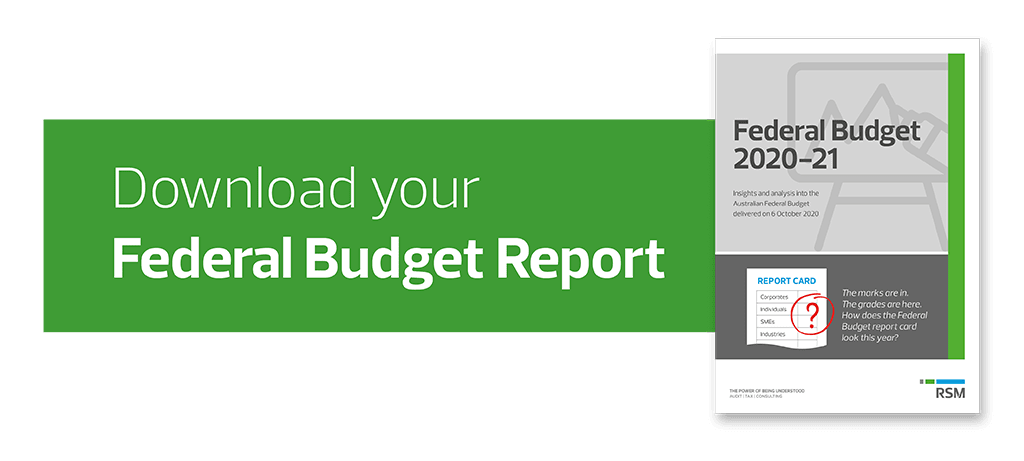What does the 2020-21 Tasmanian state budget mean for you and your business?
Much like the other State Budgets, the Tasmanian 2020-21 Budget recognises the COVID-19 pandemic has both a health element and an economic element. To this end, the Tasmanian Budget, released on 13 November 2020, makes further significant investments towards rebuilding the local economy and ensuring that the health system can continue to cope with the ongoing effects of the pandemic.
Being an economy that relies heavily on tourism and hospitality, Tasmania has been hit hard by the effects of the pandemic and an associated $347m write-down in GST receipts in 2020-21. While the headline is a deficit of around $1.1 bn for the coming year and an estimated deficit of $281m in 2021-22, the Tasmanian Government expects a return to a surplus in 2022-23, albeit a modest one of $14m. This return to surplus is underpinned by expected strong growth in the economy, which is estimated to be 3.75% in 2021-22.
At the height of the pandemic, the Government provided a range of business support and stimulus measures such as:
- The waiver or deferral of government fees and charges,
- The waiver of payroll tax for the 2020 payroll tax year for businesses in the hospitality, tourism and fishing sectors,
- $80m of business support grants and the rent and land tax waivers for businesses.
Many of these support measures will continue throughout 2020-21 to ensure Tasmanian businesses can ease their way back to business-as-usual.
Key points | Infrastructure program | Pandeminc recovery plan | State tax reform
The key points of the Budget are: 
- Net government debt, which was nil prior to this year, will be $1.854 bn in 2020-21 and will rise to $4.38 bn over the forward estimates.
- In addition to other specific measures contained in the Budget, $145m has been allocated in 2020-21 to a central COVID-19 pandemic provision to assist in meeting unknown costs associated with the pandemic.
- Over the forward estimates, the Budget provides nearly $5 bn of infrastructure investment. This is expected to support over 6,000 jobs annually and 25,000 jobs over the forward estimates. Just under half of the infrastructure budget is allocated towards better roads and bridges around the state.
- From a health perspective, there will be $9.8 bn in health funding over the next four years. Of this, an additional $391m will be rolled out across the hospital and health system, with the bulk of the funding towards upgrades or redevelopments for the Royal Hobart, Launceston General and Mersey Community hospitals.
- The Government has sought to address the significant impact of COVID-19 on the state's hospitality industry with a $10m support fund for businesses with turnover higher than $50,000 a year. The Government will also waive liquor licensing fees for 2021 and provide a reimbursement up to a capped amount against small businesses’ energy bills for the first quarter of the financial tear.
Infrastructure program 
The State Budget more than triples the investment infrastructure from five years ago to over $1 bn a year. The infrastructure pipeline includes the following:
- $2.4 bn for the State’s road network, including $576m for the new Bridgewater Bridge;
- $391m for new and upgraded health, hospital and ambulance facilities;
- $222m for new and upgraded schools, training centres and IT infrastructure;
- $200m for new prison infrastructure;
- $124m for new housing projects including the debt waiver program;
- $100m for up to 1,000 new social housing dwellings; and
- $65m to continue delivering the second Affordable Housing Action Plan.
Pandemic recovery plan 
In response to the pandemic, the Government established an advisory council to provide advice and recommendations on how best to mitigate the economic and social impacts of the pandemic. In the Budget, the Government has implemented the following measures as a result of the recommendations of the advisory council:
- Extending the payroll tax rebate, and associated grant program for small business, to apply to all apprentices, trainees and youth across all industry areas until 30 June 2022. Under the scheme, a payroll tax rebate is available for businesses that employ apprentices and trainees (of any age) or for youth employees between the ages of 15 and 24. This extension comes with a cost of approximately $22m;
- Providing joint State-Australian Government funding of $21m to provide low or no-fee training places for job seekers, school leavers and young people looking to upskill and retrain, regardless of prior qualification attainment; and
- Providing $50m to a range of initiatives to support businesses assist women back into work, support the cultural and performing arts sector, improve the environment, and invest in public housing infrastructure upgrades.
State tax reform
Other than the temporary payroll tax and land tax relief measures already provided for during 2020, there were no new state tax announcements in the Budget.
For more information
If you have any questions or require further information on the 2020-21 Tasmanian State Budget Analysis, please contact your local RSM adviser today.


